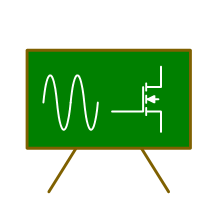This overview contains only the English lectures. For a complete overview, please switch to the German view.
Summer term 25
| Lecturers: | Univ.-Prof. Dr.-Ing. Georg Rademacher Dr.-Ing. Markus Grözing |
|---|---|
| Type: | Lecture |
| Sh: | 2 |
| Teaching Language: | English/German |
| Content: | - Advanced Analog-to-Digital Converter Design - Advanced Digital-to-Analog Converter Design - Time Interleaving of Data Converters - Clock and Frequency Generation - Layout Design for Linearity - Simulation Methods |
| Link: | C@MPUS |
Contact information for the lecturers can be found on our team page.
Winter term 24/25
| Number: | 371102220 |
|---|---|
| Lecturers: | Univ.-Prof. Dr.-Ing. Georg Rademacher Robert Kaps Rouven Klenk |
| Type: | Exercise |
| Sh: | 2 |
| Teaching Language: | German |
| Link: | C@MPUS |
| Number: | 372102510 |
|---|---|
| Lecturers: | Dr.-Ing. Markus Grözing Univ.-Prof. Dr.-Ing. Georg Rademacher Manuel Wittlinger |
| Type: | Lecture |
| Sh: | 2 |
| Teaching Language: | English/German |
| Content: | Preliminary Contents Mixed-Signal Integrated Circuits (MSIC) Mixed-signal circuits contain both analogue and digital circuits as well as the necessary circuits for the transition from one signal domain to the other, i.e. analogue-to-digital as well as digital-to-analogue converters. 1. Introduction 1.1. Overview MSIC 1.2. Signal Domains (Continuous vs Discrete Time / Value) 1.3. Signal Quality Measures (SFDR, THD, SNR, SNDR/ENOB) 1.4. Transistor Device Recapitulation (MOSFET & BJT) 2. Basic Analog and Digital Circuit Recapitulation 2.1. Basic Analog Circuits 2.1.1. Basic Amplifiers 2.1.2. Differential / Emitter-/Source-Coupled Pairs 2.1.3. Current Sources & Switches 2.1.4. Feedback for Broadband & Linear Amplifiers / Buffers 2.1.5. Bandgap Voltage Reference 2.2. Basic Digital Circuits 2.2.1. CMOS Logic & Latches 2.2.2. Current-Mode Logic / Emitter-/Source-Coupled Logic & Latches 3. Basic Mixed Signal Circuit Blocks (Signal Domain Interface) 3.1. Track & Hold Circuits 3.2. Comparators (Compare & Decide + Regenerate) 3.3. Resistive and Capacitive Weighting Networks (R-2R, SC) 4. Data Converter Design Introduction 4.1. Analog-to-Digital Converter (ADC) 4.1.1. Overview ADC Architectures 4.1.2. Basic Flash Converter (Resistor Ladder, Quantizer, Coder) 4.2. Digital-to- Analog Converter (DAC) 4.2.1. Overview DAC Architectures 4.2.2. Basic Switched Current-Source Converter (Current Sources, Current Switches, R-2R weighting network) |
| Link: | C@MPUS |
| Number: | 372102520 |
|---|---|
| Lecturers: | Dr.-Ing. Markus Grözing Univ.-Prof. Dr.-Ing. Georg Rademacher Manuel Wittlinger |
| Type: | Exercise |
| Sh: | 2 |
| Teaching Language: | English/German |
| Content: | In the exercises the knowledge from the lecture Mixed-Signal Integrated Circuits (MSIC) is used for calculations on practical examples. Dimensioning and analysis of several circuits is done. |
| Link: | C@MPUS |
| Number: | 372113510 |
|---|---|
| Lecturers: | Univ.-Prof. Dr.-Ing. Georg Rademacher Raik Elster |
| Type: | Lecture |
| Sh: | 2 |
| Teaching Language: | English/German |
| Content: | Fundamentals of optical communications: Plane waves, dispersion, attenuation, reflection • Optical fibers: Fiber modes, single and multi-mode fibers, multi-core fibers, fiber manufacturing, coupling • Light sources: Semiconductor lasers • Signal generation: directly modulated lasers, external modulators, IQ modulators • Optical receivers: Photo diodes, receivers for direct detection, coherent receivers • Optical amplification: EDFAs, noise • Optical transmission systems: noise analysis, bit-error rates, optical signal to noise ratio, nonlinear signal distortions, Digital signal processing, capacity limitations • Current research in optical fiber transmission: space-division multiplexing, integrated optics, and more! |
| Link: | C@MPUS |
| Number: | 372113520 |
|---|---|
| Lecturers: | Univ.-Prof. Dr.-Ing. Georg Rademacher Raik Elster |
| Type: | Exercise |
| Sh: | 2 |
| Teaching Language: | English/German |
| Link: | C@MPUS |


